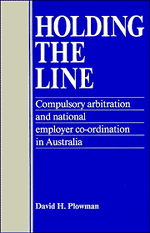Book contents
- Frontmatter
- Contents
- List of tables and figures
- List of abbreviations
- Acknowledgements
- Introduction
- Dedication
- 1 Industrial legislation and the rise of permanent employer associations 1890–1906
- 2 The Higgins era 1907–1920
- 3 Rival shops 1921–1929
- 4 Depression and recovery 1930–1939
- 5 War and government executive action 1940–1949
- 6 Consolidation 1950–1959
- 7 The National Employers' Associations 1960–1972
- 8 Confederation 1973–1988
- 9 Models of national employer co-ordination
- Appendices
- Bibliography
- Records of organisations
- Index
9 - Models of national employer co-ordination
Published online by Cambridge University Press: 05 November 2011
- Frontmatter
- Contents
- List of tables and figures
- List of abbreviations
- Acknowledgements
- Introduction
- Dedication
- 1 Industrial legislation and the rise of permanent employer associations 1890–1906
- 2 The Higgins era 1907–1920
- 3 Rival shops 1921–1929
- 4 Depression and recovery 1930–1939
- 5 War and government executive action 1940–1949
- 6 Consolidation 1950–1959
- 7 The National Employers' Associations 1960–1972
- 8 Confederation 1973–1988
- 9 Models of national employer co-ordination
- Appendices
- Bibliography
- Records of organisations
- Index
Summary
This study has sought to examine the factors leading employers to form national co-ordinating machinery as well as to explain the reasons for the different forms of co-ordination adopted at different points of time. Several co-ordinating models, some containing variants, were developed by employers over the period under review. These models may be described as:
the mutual defence model
the federation model
the alliance model
the secretariat model
the confederation model.
Successive sections of this chapter examine each of these models of co-ordination and the factors behind their development.
The mutual defence model
This was the earliest form of proposed national (and state/colonial) organisation identified in the study. Its rationale was not so much the co-ordination of employer policies or the negotiation with unions at the national or state levels as a method of stiffening employer resistance to union militancy. Under this scheme individual employers, and associations of employers, could insure themselves against the whip-sawing actions of unions. It was hoped that compensating employers for strike losses would enable them to resist union demands and thus prevent the percolation of new industrial standards. This method of mutual defence was the counterpart of the unions' method of mutual insurance and of strike funds, which attempted to make strike action less of a financial burden for members.
The logistic problems associated with the implementation of such a scheme on an Australia-wide basis, and the very different negotiatory styles adopted by employers and their associations, made such a concept difficult to bring into being.
- Type
- Chapter
- Information
- Holding the LineCompulsory Arbitration and National Employer Co-ordination in Australia, pp. 206 - 240Publisher: Cambridge University PressPrint publication year: 1989



